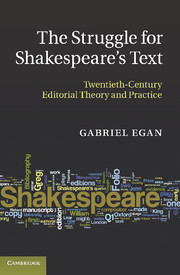Book contents
- Frontmatter
- Contents
- Preface
- Acknowledgements
- A note on references, quotations, names and pronouns
- Introduction
- 1 The fall of pessimism and the rise of New Bibliography, 1902–1942
- 2 New techniques and the Virginian School: New Bibliography 1939–1968
- 3 New Bibliography 1969–1979
- Intermezzo: the rise and fall of the theory of memorial reconstruction
- 4 New Bibliography critiqued and revised, 1980–1990
- 5 The ‘new’ New Bibliography: the Oxford Complete Works, 1978–1989
- 6 Materialism, unediting and version-editing, 1990–1999
- Conclusion: the twenty-first century
- Appendix 1 How early modern books were made: a brief guide
- Appendix 2 Table of Shakespeare editions up to 1623
- Appendix 3 Editorial principles of the major twentieth-century Shakespeare editions
- Works cited
- Index
1 - The fall of pessimism and the rise of New Bibliography, 1902–1942
Published online by Cambridge University Press: 06 December 2010
- Frontmatter
- Contents
- Preface
- Acknowledgements
- A note on references, quotations, names and pronouns
- Introduction
- 1 The fall of pessimism and the rise of New Bibliography, 1902–1942
- 2 New techniques and the Virginian School: New Bibliography 1939–1968
- 3 New Bibliography 1969–1979
- Intermezzo: the rise and fall of the theory of memorial reconstruction
- 4 New Bibliography critiqued and revised, 1980–1990
- 5 The ‘new’ New Bibliography: the Oxford Complete Works, 1978–1989
- 6 Materialism, unediting and version-editing, 1990–1999
- Conclusion: the twenty-first century
- Appendix 1 How early modern books were made: a brief guide
- Appendix 2 Table of Shakespeare editions up to 1623
- Appendix 3 Editorial principles of the major twentieth-century Shakespeare editions
- Works cited
- Index
Summary
The history of New Bibliography's rise that occupies this chapter and the next is framed by the publication of two facsimile editions of the 1623 Shakespeare Folio. One is Sidney Lee's collotype reproduction of the Chatsworth copy (owned by the Duke of Devonshire) for Oxford University Press in 1902 and the other is Charlton Hinman's idealized line-offset reproduction for W. W. Norton in 1968. Both facsimiles were widely praised for their fidelity, but they were executed along entirely different lines that usefully illustrate the fundamental change regarding our relationship to the Shakespeare texts that occurred in the twentieth century. In 1903 A. W. Pollard became J. Y. W. Macalister's assistant as editor of the journal The Library and published W. W. Greg's extended criticism of Lee's introductory matter that pointed out numerous errors of fact and introduced two elements of what came to be called the New Bibliography: a theory about the copyright notions of the period and an attempt to distinguish the kinds of manuscript used to make the Folio (Greg 1903a). Matters of detail Greg later changed his mind about – for example that printed texts were used as prompt-books and that there was no such occupation as playhouse scrivener (Greg 1903a, 275, 277) – but the core of what later became Greg's contribution to the field can be discerned in this article.
- Type
- Chapter
- Information
- The Struggle for Shakespeare's TextTwentieth-Century Editorial Theory and Practice, pp. 12 - 37Publisher: Cambridge University PressPrint publication year: 2010



